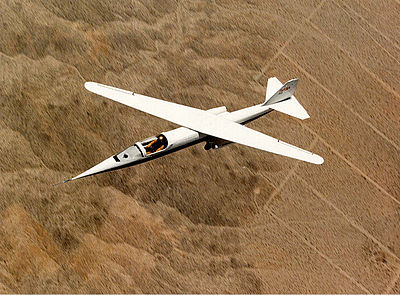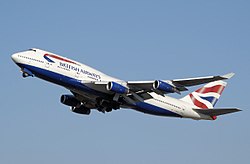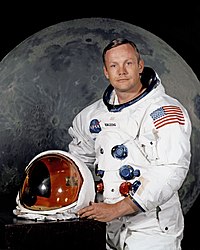Portal:Aviation
| Main page | Categories & Main topics |
|
Tasks and Projects |
The Aviation Portal

Aviation includes the activities surrounding mechanical flight and the aircraft industry. Aircraft includes fixed-wing and rotary-wing types, morphable wings, wing-less lifting bodies, as well as lighter-than-air craft such as hot air balloons and airships.
Aviation began in the 18th century with the development of the hot air balloon, an apparatus capable of atmospheric displacement through buoyancy. Some of the most significant advancements in aviation technology came with the controlled gliding flying of Otto Lilienthal in 1896; then a large step in significance came with the construction of the first powered airplane by the Wright brothers in the early 1900s. Since that time, aviation has been technologically revolutionized by the introduction of the jet which permitted a major form of transport throughout the world. (Full article...)
Selected article

Selected image

Did you know
...that the Soviet spotter aircraft Sukhoi Su-12, though approved, was never produced due to lack of manufacturing capacity in the USSR? ...that Berlin Airlift "Candy Bomber" Gail Halvorsen would wiggle the wings of his plane to identify himself to children below? ... that Wing Commander John Lerew, ordered to defend Rabaul against Japanese invasion in 1942, signaled headquarters the legendary gladiatorial phrase "We who are about to die salute you"?
General images -
In the news
- May 29: Austrian Airlines cancels Moscow-bound flight after Russia refuses a reroute outside Belarusian airspace
- August 8: Passenger flight crashes upon landing at Calicut airport in India
- June 4: Power firm helicopter strikes cables, crashes near Fairfield, California
- January 29: Former basketball player Kobe Bryant dies in helicopter crash, aged 41
- January 13: Iran admits downing Ukrainian jet, cites 'human error'
- January 10: Fire erupts in parking structure at Sola Airport, Norway
- October 27: US announces restrictions on flying to Cuba
- October 3: World War II era plane crashes in Connecticut, US, killing at least seven
- September 10: Nevada prop plane crash near Las Vegas leaves two dead, three injured
- August 6: French inventor Franky Zapata successfully crosses English Channel on jet-powered hoverboard
Related portals
Associated Wikimedia
The following Wikimedia Foundation sister projects provide more on this subject:
-
Commons
Free media repository -
Wikibooks
Free textbooks and manuals -
Wikidata
Free knowledge base -
Wikinews
Free-content news -
Wikiquote
Collection of quotations -
Wikisource
Free-content library -
Wikiversity
Free learning tools -
Wikivoyage
Free travel guide -
Wiktionary
Dictionary and thesaurus
Selected biography
Before becoming an astronaut, Armstrong was in the United States Navy and saw action in the Korean War. After the war, he served as a test pilot at the National Advisory Committee for Aeronautics (NACA) High-Speed Flight Station, now known as the Dryden Flight Research Center, where he flew over 900 flights in a variety of aircraft. As a research pilot, Armstrong served as project pilot on the F-100 Super Sabre A and C aircraft, F-101 Voodoo, and the Lockheed F-104A Starfighter. He also flew the Bell X-1B, Bell X-5, North American X-15, F-105 Thunderchief, F-106 Delta Dart, B-47 Stratojet, KC-135 Stratotanker and Paresev. He graduated from Purdue University.
Selected Aircraft

The Boeing 747 is a widebody commercial airliner, often referred to by the nickname Jumbo Jet. It is among the world's most recognizable aircraft, and was the first widebody ever produced. Manufactured by Boeing's Commercial Airplane unit in the United States, the original version of the 747 was two and a half times the size of the Boeing 707, one of the common large commercial aircraft of the 1960s. First flown commercially in 1970, the 747 held the passenger capacity record for 37 years.
The four-engine 747 uses a double deck configuration for part of its length. It is available in passenger, freighter and other versions. Boeing designed the 747's hump-like upper deck to serve as a first class lounge or (as is the general rule today) extra seating, and to allow the aircraft to be easily converted to a cargo carrier by removing seats and installing a front cargo door. Boeing did so because the company expected supersonic airliners (whose development was announced in the early 1960s) to render the 747 and other subsonic airliners obsolete; while believing that the demand for subsonic cargo aircraft would be robust into the future. The 747 in particular was expected to become obsolete after 400 were sold but it exceeded its critics' expectations with production passing the 1,000 mark in 1993. As of September 2023, 1,574 aircraft have been built, with the final delivery in January 2023.
The 747-8, the latest version in service, is among the fastest airliners in service with a high-subsonic cruise speed of Mach 0.855 (564 mph or 908 km/h). It has an intercontinental range of 7,730 nautical miles (14,320 km; 8,900 mi). The 747-8I (passenger version) can accommodate 467 passengers in a typical three-class layout. The 747-8 completed production on 6 December 2022 and the final 747 was delivered to Atlas Air on 31 January 2023.
Today in Aviation
- 2011 – In the 2011 Avis Amur Antonov An-12 crash, an Antonov An-12 crashes at Omsukchan, Russia due to an engine fire, killing all 11 on board.
- 2011 – The Government of the United Arab Emirates turns a Libyan Air Force Ilyushin Il-76TD it had seized at Dubai over to the Libyan provisional National Transitional Council at Benghazi, Libya. It becomes the Free Libyan Air Force's first military transport aircraft.[1]
- 2010 – JetBlue flight attendant incident was an altercation that occurred after JetBlue Airways Flight 1052, a flight from Pittsburgh to New York City, had landed. The incident garnered significant media attention when, upon landing, Steven Slater, a flight attendant, announced over the plane’s public address system that he had been called an obscenity by a passenger, quit his job, deployed the evacuation slide at the terminal gate, and slid down it. Slater claimed to have been injured by a passenger when he instructed her to sit down. Slater’s account of the event was not corroborated by others.
- 2007 – Air Moorea Flight 1121, operated on an Air Moorea de Havilland Canada DHC-6 Twin Otter airplane, crashed shortly after taking off from Temae Airport on Moorea island in French Polynesia; the plane was bound for Tahiti. According to the official report by Bureau d’Enquêtes et d’Analyses pour la sécurité de l’Aviation Civile, all 20 occupants, including 19 passengers and one crew member, died.
- 2006 – First flight of the BAE Skylynx II UAV
- 2006 – Transatlantic aircraft plot was a terrorist plot to detonate liquid explosives carried on board at least 10 airliners travelling from the United Kingdom to the United States and Canada. The plot was discovered and foiled by British police before it could be carried out and, as a result, unprecedented security measures were immediately put in place.
- 1996 – Sir Frank Whittle, inventor of the jet engine, dies at 89.
- 1995 – Aviateca Flight 901, a Boeing 737, crashes into San Vicente volcano while on approach to Cuscatlán International Airport; all 65 on board die.
- 1980 – Jacqueline Cochrane, US pilot / first female to fly faster than sound, dies at 70.
- 1976 – USSR launches Luna 24, last Lunar flight to date from Earth.
- 1976 – First flight of the Boeing YC-14
- 1976 – Sikorsky YUH-60A UTTAS, 73-21650, first prototype to fly, fully loaded with 14 Army personnel during testing, makes emergency landing at 2315 hrs. in a wooded area of Fort Campbell, Kentucky, due to vibration caused by outer skin of a main rotor blade coming loose. Due to heavy mist, pilot CW2 Charlie Lovell believes he is landing in a cornfield but instead comes down in a pine forest. Main rotor scythes down 40 pines, some as large as five inches in diameter, as it lands, but main rotor blades do not shatter. Only injury is to a soldier who bumps his head against a truncated pine as he egresses the helicopter. After cutting down stumps around the aircraft, and replacing the main and tail rotors, the now-nicknamed "Phoenix" is flown out of the site three days later. US Army, duly impressed by the crash survivability shown, will award the UTTAS contract to Sikorsky and the design will be named the Blackhawk. This airframe will be destroyed in a crash on 19 May 1978.
- 1975 – Japan Air Lines establishes Japan Asia Airways as a subsidiary
- 1974 – A Buffalo of 116 ATU was shot down by a Syrian Missile while on a routine flight between Beirut and Damascus. The flight was commanded by Capt. Gary Foster of Comox. Nine Canadians lost their lives.
- 1974 – RAF McDonnell Douglas/Hawker Siddeley F-4M Phantom FGR.2, XV493, 'F', of No. 41 Squadron was involved in fatal mid-air collision with a Piper Pawnee crop-sprayer, G-ASVK, over Fordham Fen near Downham Market, Norfolk, England. Two Phantom and one Pawnee crew all KWF.
- 1970 – LANSA Flight 502, a Lockheed L-188 Electra turboprop, crashes and burns shortly after takeoff from Cuzco, Peru, killing 99 people on the plane and two on the ground; among the dead are 49 U.S. high school exchange students.
- 1967 – The world’s first radar-equipped antsubmarine helicopter enters service, a Royal Navy Fleet Air Arm Westland Wessex HAS.3 with No. 814 Squadron.
- 1961 – The Holtaheia Accident: An Eagle Airways Vickers VC.1 Viking crashes at Holta, Strand, Norway, killing all 39 on board, including 36 people from the Archbishop Lanfranc School.
- 1958 – A 1958 Central African Airways plane crash occurred near Benina International Airport due to pilot error, killing 36 of 54 on board.
- 1952 – Lt Peter Carmichael of No. 802 Squadron FAA aboard HMS Ocean claims the Fleet Air Arm's first MiG-15 kill, from a Hawker Sea Fury.
- 1950 – The first Canadian built Sabre Mark 1 flew.
- 1950 – Al Lily became the first Canadian to break the Sound Barrier.
- 1949 – US Navy pilot Lt. J. L. "Pappy" Fruin of VF-101 loses control of his McDonnell F2H-1 Banshee at 500 mph and 30,000 feet and ejects over Walterboro, South Carolina, becoming the first American Naval aviator to use an ejector seat during an actual in-flight emergency. VF-101 was the first Navy unit to receive the type.
- 1949 – The first Canadian passenger jet (second in the world after the British), the Avro Canada Jetliner, is flown at Malton. Despite its advanced design, it never saw production and was later sold for scrap.
- 1945 – Carrier aircraft of Task Force 38 conduct devastating strikes against Japanese airfields in northern Honshu where the Japanese had been marshalling aircraft for a planned major suicide strike on B-29 bases in the Mariana Islands. The Americans claim 251 Japanese aircraft destroyed and 141 damaged.
- 1945 – B-29 Bockscar drops a plutonium-239 nuclear weapon, Fat Man, on Nagasaki
- 1942 – The P-38 Lightning fighter scores its first aerial victories when two P-38 s of the 343rd Fighter Group flown by U. S. Army Air Forces Lieutenants K. Ambrose and S. A. Long shoot down two Japanese Kawanishi H6 K4 flying boats near the Aleutian Islands.
- 1941 – Flying a Dornier Do 215 B-5 night fighter, Luftwaffe Oberleutnant Ludwig Becker achieves Germany’s first aerial victory employing airborne radar, using a Lichtenstein radar to detect and close with a British Vickers Wellington bomber participating in a raid on Hamburg, Germany, before shooting down the Wellington.
- 1936 – Six aircraft support a Republican seizure of Ibiza.
- 1918 – Eight Italian Ansaldo SVA biplanes of the 87 Squadriglia “Serenimissa”, led by Gabriele D’Annunzio, fly over Vienna for 30 min taking photographs and dropping leaflets before returning to base without loss.
- 1896 – Otto Lilienthal crashes during a routine flight in the hills of Stölln and dies next day because of a spinal injury.
- 1884 – The first fully controllable free-flight is made in a French Army dirigible La France by Charles Renard and Arthur Krebs. The electric-powered flight covers 8 km (5 miles) in 23 min. It was the first full circle flight with landing on the starting point.
References
- ^ "Cargo Plane Handed Over to Libya Rebels". Arabs Today. Agence France-Presse. 11 August 2011. Retrieved 28 August 2011.
- Shortcuts to this page: Portal:Airplanes • P:AVIA



















































